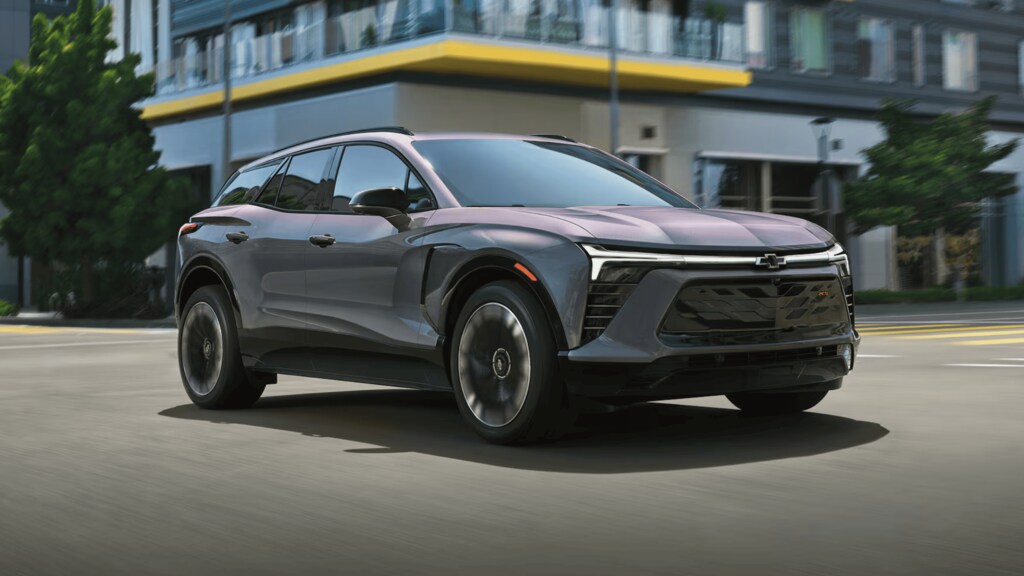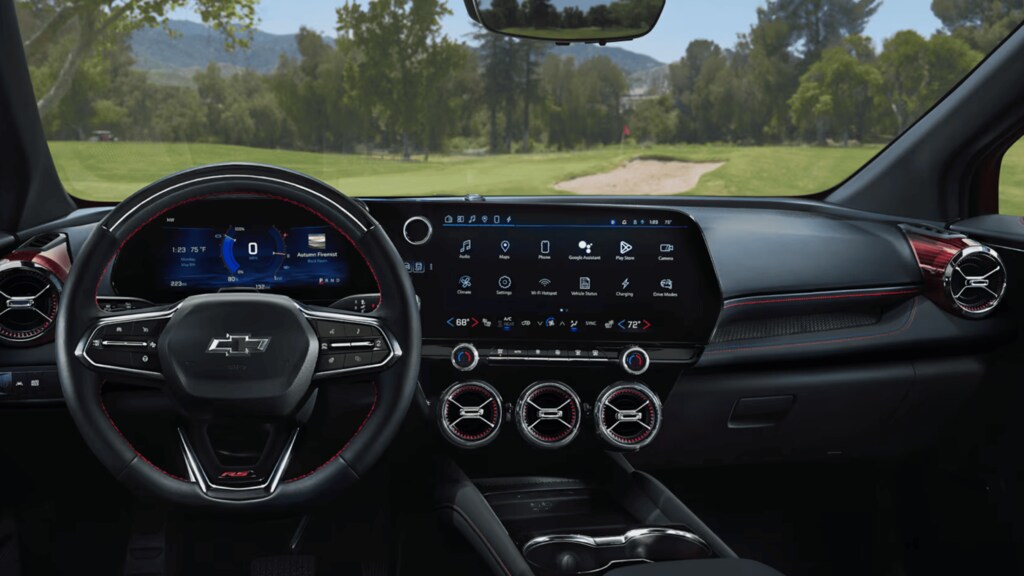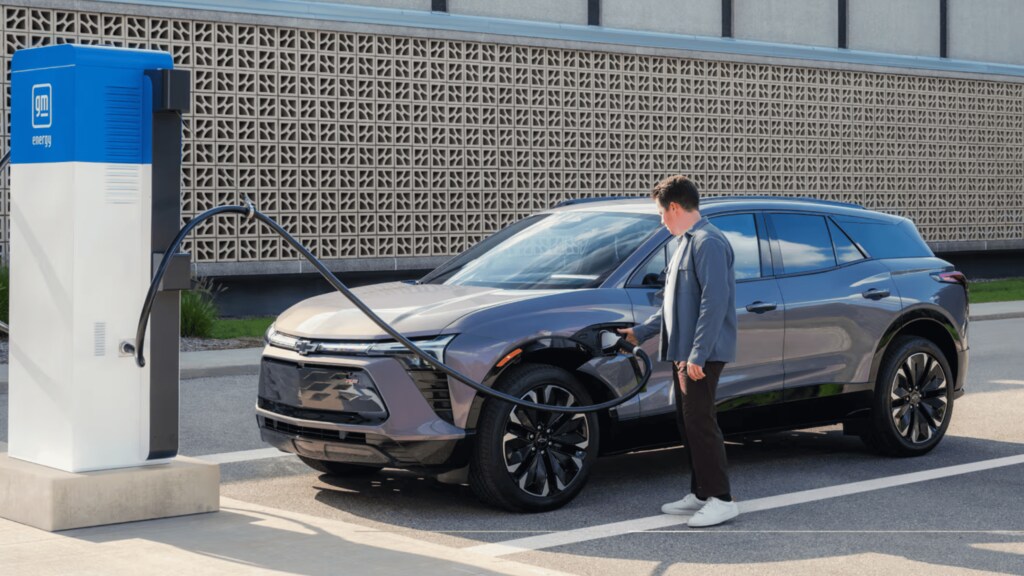

Safety and Driver Assistance Systems
The 2025 Chevrolet Blazer EV includes comprehensive safety systems standard on all models. Airbag coverage includes frontal airbags, knee airbags, seat-mounted side-impact airbags for the driver and front passenger, and roof-rail mounted head-curtain airbags for outboard seating positions. A passenger sensing system for the front passenger seat is also standard.
Chevy Safety Assist is included and consists of several active safety features. These include automatic emergency braking, front pedestrian braking, lane keep assist with lane departure warning, following distance indicator, forward collision alert, and IntelliBeam® automatic high beams. A safety alert seat and rear seat reminder further enhance occupant protection.
Optional driver confidence features are available in a convenience and driver confidence package. This package adds adaptive cruise control, rear pedestrian alert, side bicyclist alert, high-definition surround vision, enhanced automatic emergency braking, intersection automatic emergency braking, and reverse automatic braking. The RS trim offers additional features such as a head-up display and a rear camera mirror.

Battery Technology and Driving Range
The 2025 Chevrolet Blazer EV utilizes lithium-ion battery packs with NCMA cathode chemistry and a blended graphite anode. This chemistry is chosen for its energy density and thermal management properties. Two battery pack sizes are available. The FWD and AWD models are equipped with an 85 kWh battery, while the RWD and SS models carry a larger 102 kWh battery to support increased power needs and extended range.
EPA-estimated driving ranges differ by drivetrain and battery size. The FWD variant offers an estimated 312 miles on a full charge. The AWD model has an estimated range of 283 miles. The RWD version extends that range to 334 miles. The SS Performance AWD is estimated to achieve 303 miles.
Charging capabilities include AC charging at up to 11.5 kW and DC fast charging that can deliver up to 150 kW for 85 kWh battery models and up to 190 kW for 102 kWh battery models. For example, DC fast charging provides approximately 81 miles of range in 10 minutes for the FWD model and up to 87 miles for the RWD variant. The AWD and SS trims offer slightly lower but competitive DC fast charging ranges within the same timeframe.
Charging from a 120V outlet provides about 4 miles of range per hour of charge. A 240V supply with a 7.7 kW dual-level charge cord delivers roughly 20 to 25 miles of range per hour depending on the drivetrain. The highest AC charging rate of 11.5 kW increases range gain to approximately 29 to 35 miles per hour of charge, varying by model. Home charging setups require a dedicated 60A station professionally installed, which is sold separately.

Engine Performance and Powertrain Configurations
The 2025 Chevrolet Blazer EV offers several drivetrain options that differ in motor types, power output, and torque. The base front-wheel drive (FWD) model utilizes a single permanent magnetic drive motor paired with a single gearset. This motor produces 220 horsepower and 243 pound-feet of torque with a final drive ratio of 11.59:1.
The all-wheel drive (AWD) system features dual motors with individual gearsets. The front motor is a permanent magnet bar-wound type, and the rear motor is an induction motor without magnets. Together, these motors produce a combined output of 300 horsepower and 355 pound-feet of torque. The front and rear final drive ratios are 11.59:1 and 10.99:1 respectively.
There is also a rear-wheel drive (RWD) variant that uses a single permanent magnetic motor delivering 365 horsepower and 325 pound-feet of torque. The final drive ratio in this setup is 11.63:1.
The most powerful version, the SS Performance AWD, is equipped with dual permanent magnetic drive motors at both front and rear axles. It produces 615 horsepower and 650 pound-feet of torque when operating in Wide Open Watts mode. The final drive ratios for this configuration are 9.87:1 in the front and 10.49:1 in the rear.
Chassis, Suspension, and Dimensions
The 2025 Chevrolet Blazer EV uses a 5-link independent suspension system for both the front and rear wheels. Steering is managed through Continuously Variable Electric Power Steering, with steering ratios of 18.46:1 for FWD, AWD, and RWD trims, and a quicker 15.8:1 ratio for the SS variant. The turning circle measures approximately 39.7 feet from wall to wall, enabling maneuverability in urban environments.
Brake systems vary with trim levels. Standard models are equipped with four-wheel disc brakes, while the SS model includes Brembo® six-piston fixed caliper front brakes and larger rotors measuring 15.3 inches in the front and 13.6 inches in the rear, designed to handle higher performance demands.
Exterior dimensions are consistent across trims with a wheelbase of 121.8 inches and overall lengths of about 192.2 inches for most models, with the SS slightly longer at 192.6 inches. Width without mirrors measures 78.0 inches and 86.5 inches with mirrors included. Height ranges around 65 inches, with the SS slightly lower at 64.8 inches. Ground clearance varies from 7.5 inches in the SS to 8.0 inches in the FWD, supporting light off-road capability and road clearance balance.
Wheel sizes and tire profiles depend on the trim, starting at 19 inches on the LT with 255/60R19 tires, 21 inches on the RS with 275/45R21 tires, and up to 22 inches on the SS with 275/40R22 tires.
Interior Space and Practicality
The interior dimensions support comfortable seating for passengers with first-row headroom measuring 40.9 inches without a sunroof and reducing to 39.4 inches when equipped with one. Rear headroom is 38.1 inches without a sunroof and 36.7 inches with. Legroom in the front reaches up to 44.2 inches, and rear legroom measures 38.9 inches. Shoulder room across the first and second rows is nearly 59 inches, providing adequate lateral space.
Cargo capacity varies depending on seat configuration and sunroof installation. When the rear seats are folded down, cargo volume is approximately 59 cubic feet, slightly increasing with a sunroof. Behind the rear seats, cargo space is around 25.5 to 25.8 cubic feet, depending on sunroof presence.
Visit Powers Swain Chevrolet in Fayetteville, NC
Testing the 2025 Chevrolet Blazer EV provides an opportunity to evaluate its multiple electric powertrain options and advanced technology features firsthand. Drivers can experience the precise handling facilitated by the independent suspension and electric power steering. They can also assess the convenience of Super Cruise® driver assistance available on select trims and explore the safety features designed to enhance confidence on the road. Scheduling a test drive at Powers Swain Chevrolet in Fayetteville, NC offers direct exposure to the capabilities of this electric SUV and an understanding of how its range, charging capabilities, and powertrains align with individual driving needs.
Make an Inquiry
* Indicates a required field